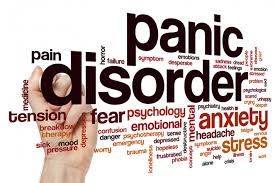Panic disorder – A type of anxiety disorder characterized by repeated episodes of intense  anxiety or panic.
anxiety or panic.
- There is a stronger bodily component to panic attacks than to other forms of anxiety.
- The attacks are accompanied by feelings of sheer terror and a sense of imminent danger or impending doom and by an urge to escape the situation.
- For a diagnosis of panic disorder to be made, the person must have experienced repeated, unexpected panic attacks, and at least one of the attacks must be followed by one of the following (American Psychiatric Association, 2000)
- At least a month of persistent fear of subsequent attacks
- Worry about the implications or consequences of the attack
- Significant change in behavior
Theoretical Perspectives
- The prevailing view of panic disorder reflects a combination of cognitive and biological factors, of misattributions misperceptions of underlying causes on the one hand and physiological reactions on the other.
- Perceiving these bodily sensations as dire threats induces anxiety, which is accompanied by activation of the sympathetic nervous system.
- The changes in bodily sensations that trigger a panic attack may result from many factors, such as unrecognized hyperventilation (rapid breathing), exertion, changes in temperature, or reactions to certain drugs or medications.
Biological Factors
- Evidence suggests that genetic factors are at work in explaining proneness to panic disorder
- The biological underpinnings of panic attacks may involve an unusually sensitive alarm system or fear network in the brain involving the limbic system and frontal lobes that normally respond to cues of threat or danger.
- Psychiatrist Donald Klein (1994) proposed a variation of the alarm model called the suffocation false alarm theory.
Cognitive Factors
- In referring to the anxiety facing the nation in the wake of the economic depression of the 1930s, President Franklin Roosevelt said in his 1932 inaugural address, “We have nothing to fear but fear itself.”
- These words echo today in research examining the role of fear of fear, or anxiety sensitivity (AS), in determining proneness to anxiety disorders, such as panic disorder, agoraphobia, and generalized anxiety disorder.
Treatment Approaches
- The most widely used forms of treatment for panic disorder are drug therapy and cognitive-behavioral therapy. Drugs commonly used to treat depression, called antidepressant drugs, also have antianxiety and antipanic effects.
- The term “antidepressants” may be something of a misnomer since these drugs have broader effects than just treating depression.
- A potential problem with drug therapy is that patients may attribute clinical improvement to the drugs and not their own resources.

References:
Bernstein, D.A. & Nash, P.W. (2008). Essentials of psychology (4th ed.) Boston: Houghton Mifflin Company.
Comer, R.J. (2013). Abnormal Psychology (8th ed). Worth Publishers
Diagnostic and Statistical Manual of Mental Disorders, (DSM-5) American Psychiatric Publishing, 2013
Feldman, R. (2013). Essentials of understanding psychology (11th ed.). New York, NY: McGraw-Hill.
Friedman, H.S. & Schustack, M.W. (2012), Personality: classic theories and modern research (5th ed). Boston: Pearson Allyn & Bacon.
McGraw-Hill.McGraw Hill Higher Education (2013), The McGraw Hill Companies, Inc.
Ryckman, R. M. (2013). Theories of personality (10th ed.). Mason, OH: Cengage Learning.
Sue,Sue, and Sue (2014). Understanding Abnormal Behavior (10th Ed), Cengage Learning
